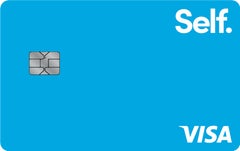Even though the First Access Visa Card can technically help you build credit, there are quite a few downsides to using this card, such as the slew of fees and lack of cardholder perks and credit-building features.
Rates and fees: Packs on high costs for cardholders
Like many other credit-building cards, the downsides to the First Access Visa are buried in the credit card agreement’s fine print. The card charges exorbitant interest and maintenance fees, even for a card designed for people with poor credit. With all of the First Access Visa card’s fees combined, you could spend close to $300 a year (the same amount as your initial credit limit) just to hold the card.
- APR: There is an incredibly high 35.99 percent APR on purchases (see terms) and cash advances (see terms), and any interest charges have a minimum price of $1.
- Sign-on fee: First Access charges a one-time program fee of $95 once your application is approved.
- Annual fee: The first year’s fee is $75, charged upfront and deducted from your overall credit limit. This means your $300 credit limit will actually start out at just $225. After the first year, the fee drops to $48 annually. There is also a $29 annual fee on supplementary cards.
- Monthly service fees: While there is no monthly service fee in the first year, this kicks in from month 13 at a cost of $8.25 per month (or another $99 per year).
- Credit limit increase fee: After the first year, you become eligible for a limit increase assessment. The cost of this assessment is 25 percent, meaning that if your limit is increased by $50, the fee is $12.50.
Other fees
- Late payment and returned payments fees are quite steep at up to $41 per incident.
- There is a cash advance fee beginning in the second year, which costs $10 or 3 percent per transaction, whichever is more.
- If you want one of First Access’s card designs, there’s a $9.95 Premium Plastic Card Design fee.
- First Access will impose a $35 Express Delivery fee for express delivery of your credit card
- First Access may charge a $3 copying fee for each requested duplicate of any monthly billing statement or other document unless the request is made due to a billing error dispute.
From annual fees to monthly maintenance fees and even one-time processing fees, these charges can eat into any available credit limit and hinder your ability to improve your credit score effectively.
Welcome offer: No monthly fees and cash advance fees for 12 months
In lieu of a standard introductory APR or rewards offer, the First Access Visa charges no monthly or cash advance fees for the first year of card ownership. Even though this card does not have a traditional welcome offer in the form of cash back, points or miles — considering the high fees charged on the card, waiving the monthly service fee of $8.25 and the cash advance fee ($10 or 3 percent, whichever is greater) will come as a relief.
Credit-building: Only reports to credit bureaus
The First Access Visa Card falls short in terms of credit-building features. When it comes to a credit-building card, one would expect additional tools and resources to help with establishing or improving credit. However, the card lacks these crucial features and, as a result, doesn't really measure up to similar credit-building cards.
Without additional credit-building tools, such as credit score tracking or credit education programs, you are left with little guidance on how to effectively manage and improve your credit. Other credit-building cards often provide tools like credit tracking apps, personalized recommendations and access to credit education resources. These features not only help you understand the factors that affect your credit score but also encourage responsible financial behavior.
Additionally, the lack of credit limit increases over time for responsible usage can be discouraging. Many credit-building cards gradually increase the credit limit as the cardholder demonstrates responsible credit behavior. Managing greater amounts of credit is an essential part of growing as a responsible credit user and important to maintaining a healthy credit utilization ratio, so it’s a shame the First Access Visa doesn’t offer a timeline on such increases (and worse, charges a fee when it does grant them). While reporting to credit bureaus is essential, it is just one piece of the puzzle when it comes to establishing a positive credit history.
Cardholder perks: Barely offers the basics
The First Access Visa Card offers a couple of basic features:
- Supplementary cards allowed: If you need an additional card for a spouse or partner, you can get one. You’ll be charged another annual fee and share the credit limit, so it’s likely this won’t prove worth the cost and effort.
- Wide card acceptance across the U.S.: Since the First Access Visa is a Visa credit card, virtually all merchants across the U.S. and online will accept this credit card. However, you can’t make charges abroad with this card.
In the realm of credit-building cards, this minimal feature set is not uncommon. But the card falls short compared to other similar cards that may offer more robust rewards programs, credit score tracking or other benefits that incentivize card usage and responsible financial behavior.






